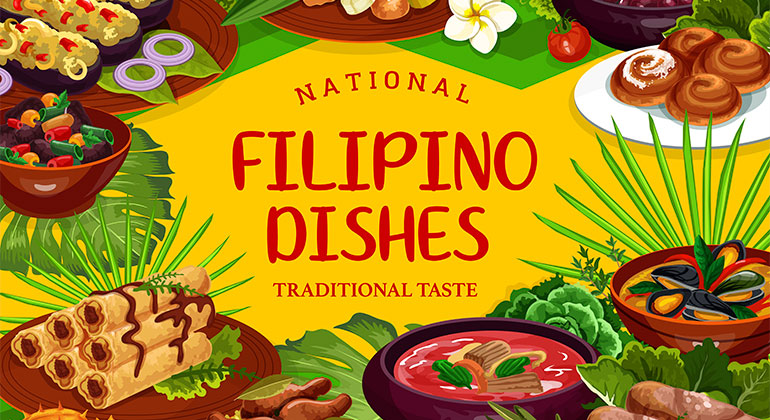Enjoy the Magical Flavors of Filipino Food
Filipino Food is a unique blend of different cultures that have influenced the Philippines throughout its history. With a combination of Malay, Spanish, Chinese, and American influences, Filipino Food offers an exciting and diverse range of flavors. From adobo to sisig to lechon, Filipino food has an amazing variety of dishes that are not only delicious but also healthy and nutritious. In this post, we will explore the magical flavors of Filipino Food, its history, and the ingredients that make it so unique. Join us as we take a culinary journey through the Philippines and discover some of the most popular and delicious dishes that this wonderful cuisine has to offer.

1. Introduction to Filipino cuisine
Filipino Food is a vibrant and diverse culinary tradition that reflects the rich cultural heritage of the Philippines. Drawing influences from Malay, Spanish, Chinese, and American cuisines, Filipino dishes offer a unique blend of flavors, textures, and techniques that are sure to tantalize your taste buds.
The Philippines, an archipelago of over 7,000 islands, is blessed with an abundance of fresh and diverse ingredients. From succulent seafood caught straight from the pristine waters surrounding the islands to tropical fruits bursting with sweetness, Filipino cuisine celebrates the natural bounty of the land and sea.
One of the defining characteristics of Filipino cuisine is the skillful use of aromatic herbs and spices. Garlic, onions, ginger, and chili peppers are just a few of the key ingredients that add depth and complexity to dishes. These flavors are often balanced with the sourness of vinegar, the sweetness of coconut milk, or the umami richness of fermented fish sauce known as “patis.”
Rice, being a staple crop in the Philippines, plays a central role in Filipino meals. It is often served alongside various dishes and serves as the foundation of iconic Filipino dishes like adobo, sinigang, and kare-kare. The versatility of rice allows it to be enjoyed in different forms, from plain steamed rice to the fragrant and colorful bibingka or suman.
Filipino cuisine also showcases a wide variety of cooking methods, from grilling and frying to stewing and braising. Each region in the Philippines has its own specialties and culinary traditions, resulting in a diverse array of flavors and dishes. Whether you’re indulging in the fiery and flavorful dishes of Bicol or savoring the delicate flavors of Visayan cuisine, Filipino food offers a truly unforgettable culinary experience.
In this blog series, we will take you on a culinary journey through the enchanting world of Filipino cuisine. From classic favorites to hidden gems, we will explore the magical flavors that make Filipino food so special. Get ready to tantalize your taste buds and embark on a gastronomic adventure like no other.
2. The diverse influences on Filipino Food
Filipino cuisine is a unique and vibrant blend of flavors influenced by a rich tapestry of cultures. Over the centuries, the Philippines has been a melting pot of various Asian, European, and indigenous culinary traditions, resulting in a truly diverse and magical cuisine.
One of the major influences on Filipino cuisine is the Malay and Indonesian culture. The Austronesian migration brought with it cooking techniques such as grilling and the use of coconut milk, which have become integral parts of Filipino cooking. These influences can be seen in popular dishes like adobo, a savory meat stew marinated in vinegar and soy sauce, and sinigang, a sour soup made with tamarind broth.
The arrival of Spanish colonizers in the 16th century introduced a whole new set of ingredients and cooking methods. Spanish flavors like garlic, onions, and tomatoes became staples in Filipino kitchens. This fusion of Spanish and indigenous flavors gave birth to iconic dishes like paella, lechon (roasted pig), and the famous dessert, halo-halo.
Chinese immigrants also played a significant role in shaping Filipino cuisine. Their culinary expertise introduced stir-frying, noodle dishes, and dim sum to the local food scene. Chinese-Filipino dishes such as pancit, lumpia, and siopao have become beloved staples in Filipino households and restaurants.
In more recent years, American fast food culture has also made its mark on Filipino cuisine. The Philippines has embraced dishes like fried chicken, burgers, and spaghetti with a distinct Filipino twist. This fusion of American and Filipino flavors has given rise to unique dishes like Jollibee’s Chickenjoy and spaghetti sweetened with banana ketchup.
The indigenous culture of the Philippines cannot be overlooked when discussing the diverse influences on Filipino cuisine. Each region in the country has its own traditional dishes and cooking techniques, showcasing the abundance of local ingredients and unique flavors. From the spicy Bicol Express of the Bicol region to the hearty and smoky flavors of Mindanao’s grilled meats, Filipino cuisine reflects the rich biodiversity and cultural heritage of the archipelago.
Enjoy the Magical Flavors of Filipino Food means delving into a world of culinary influences that have shaped the country’s gastronomic landscape. From the harmonious blending of Malay, Spanish, Chinese, and indigenous flavors to the modern twists influenced by American fast food, Filipino cuisine truly offers a culinary adventure that is both familiar and delightfully unexpected.
